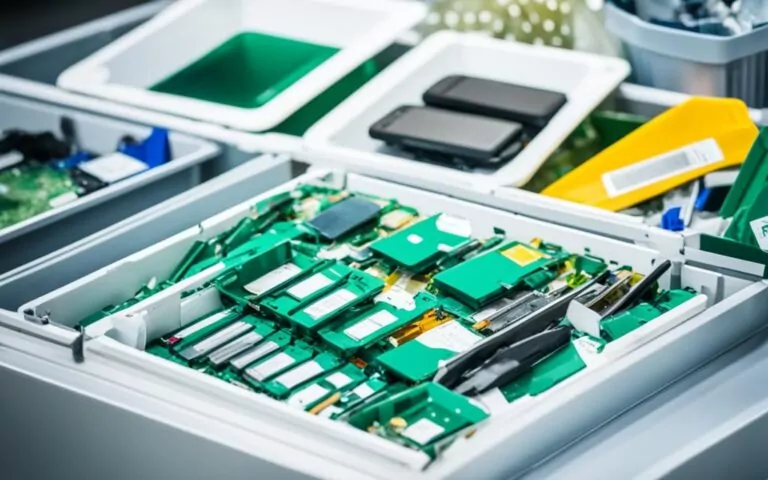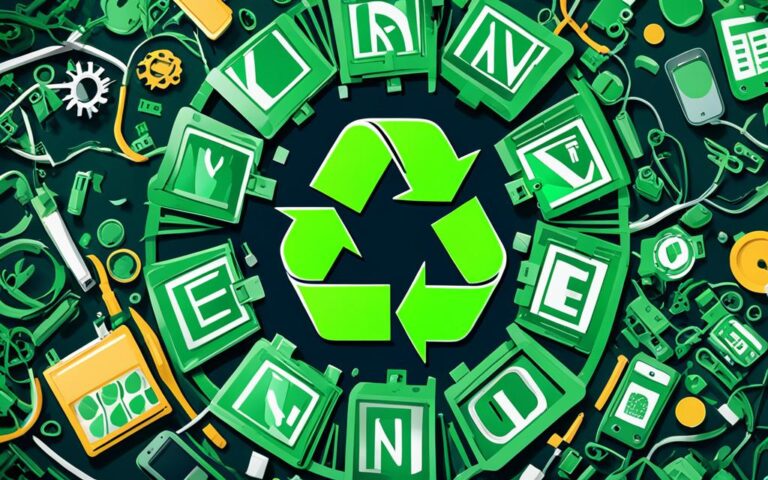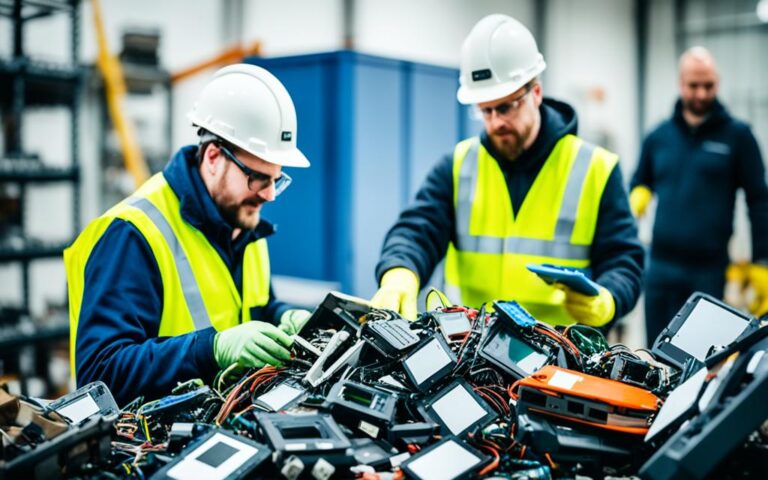The Future of Tablet Recycling and Sustainability
Electronic waste, or e-waste, is a growing concern globally. In 2019, 53.6 million metric tons of e-waste were generated worldwide, a 21% increase from 2014. E-waste poses significant environmental and health risks, especially in regions with informal recycling activities. Proper e-waste management is crucial to reduce greenhouse gas emissions and protect the environment.
As consumers, we have the power to contribute to sustainability by repairing and recycling electronic devices. By making conscious choices, such as tablet recycling, we can help minimize the impact of electronic waste on our planet. Additionally, it is essential for producers to prioritize durability and recyclability in their designs to ensure a more sustainable approach.
The future of tablet recycling and sustainability lies in our hands. Let us work towards creating a greener and cleaner world by taking responsible actions today.
Understanding the Environmental and Health Impacts of E-waste
Properly managing e-waste is crucial to protect the environment and human health. Improper disposal of electronic devices can have significant environmental impacts, posing health risks, and contributing to greenhouse gas emissions.
When e-waste is not managed correctly, hazardous chemicals can contaminate the environment, leading to adverse effects on ecosystems and biodiversity. This contamination can also pose health risks, especially for vulnerable groups like women and children.
“Improper e-waste management can lead to hazardous chemicals contaminating the environment and causing health risks, particularly for vulnerable groups like women and children.”
In addition to environmental and health concerns, e-waste also contributes to greenhouse gas emissions. In 2019 alone, improper disposal of e-waste resulted in the release of approximately 98 million metric tons of CO2 equivalents. This exacerbates the greenhouse gas emissions associated with mining and refining processes.
“It also contributes to substantial greenhouse gas emissions, with 98 million metric tons of CO2 equivalents released in 2019 alone.”
To mitigate these impacts, responsible e-waste management is essential. This includes implementing proper recycling and disposal methods to minimize environmental contamination and reduce greenhouse gas emissions. Governments, organizations, and individuals must work together to ensure the safe and sustainable handling of e-waste.
“Responsible e-waste management is essential to mitigate these impacts and protect both the environment and human health.”
| Environmental Impacts of Improper E-waste Management | Health Risks of Improper E-waste Management | Greenhouse Gas Emissions from E-waste |
|---|---|---|
| – Contamination of ecosystems and biodiversity | – Increased health risks for vulnerable groups | – 98 million metric tons of CO2 equivalents released in 2019 |
| – Soil and water pollution | – Exposure to hazardous chemicals | – Exacerbates emissions from mining and refining |
| – Depletion of natural resources | – Respiratory and cardiovascular issues | – Contributes to climate change |
“To mitigate these impacts, responsible e-waste management is essential.”
By understanding and addressing the environmental and health impacts of e-waste, we can work towards a more sustainable future and ensure the well-being of both our planet and its inhabitants.
The Importance of Measuring and Communicating Environmental Impact
Measuring and communicating environmental impact is crucial for companies to identify areas of excessive impact, make informed decisions, and meet the demands of a sustainability-conscious market.
Companies can use key performance indicators (KPIs) like carbon footprint, water consumption, and waste management practices to track the dimensions of impact. By measuring these factors and assessing their environmental performance, companies can compare themselves to industry standards and identify areas for improvement.
One effective tool for measuring environmental impact is life cycle assessments, which analyze the environmental impact of a product throughout its entire life cycle. This includes the extraction of raw materials, manufacturing, transportation, use, and end-of-life management. By understanding the complete life cycle, companies can make more informed decisions and prioritize sustainable practices.
Eco-efficiency systems also play a vital role in measuring environmental impact. These systems consider the efficiency of resource use, waste generation, and emissions in relation to the value provided by the product or service. By incorporating eco-efficiency principles into their operations, companies can optimize their environmental performance and reduce their overall impact.
In addition to measuring environmental impact, it is essential for companies to communicate their findings, progress, and commitments to stakeholders. Transparent reporting and periodic updates help build trust, foster engagement, and demonstrate compliance with regulatory requirements. Sharing environmental impact data can also inspire other companies to take action and contribute to a more sustainable future.
“Measuring and communicating environmental impact is not just about compliance; it’s about building a sustainable and resilient future that benefits both businesses and the planet.”
By prioritizing the measurement and communication of environmental impact, companies can not only meet the expectations of a sustainability-conscious market but also drive positive change and create a more sustainable future for all.
Strategies to Improve Environmental Impact in the Tech Industry
Tech companies are at the forefront of driving sustainability and adopting strategies to minimize their environmental impact. By incorporating recycled materials, prioritizing device reparability, enhancing energy efficiency, and extending the lifespan of devices, they are taking significant steps towards creating a greener future.
Incorporating Recycled Materials
One of the key strategies employed by tech companies is the increased use of recycled materials in packaging and device components. By sourcing materials from post-consumer waste and implementing closed-loop recycling systems, they reduce the demand for virgin resources and minimize the environmental footprint of their products.
Device Reparability
Improving device reparability is another crucial aspect of sustainability in the tech industry. Brands are making spare parts readily available and designing products for easier repairs. This allows consumers to extend the lifespan of their devices, reducing electronic waste and promoting a more circular economy.
Energy Efficiency
Reducing energy consumption is a priority for tech companies aiming to improve their environmental impact. They achieve this through optimized power allocation, energy-efficient designs, and innovative cooling systems. By minimizing energy consumption during both active use and standby modes, they contribute to overall energy conservation.
Extended Lifespan
Extending the lifespan of devices is an essential strategy to reduce electronic waste. Tech companies are implementing various initiatives, such as providing extended operating system (OS) support and encouraging trade-in programs. This allows users to utilize their devices for a longer period before upgrading, reducing the overall environmental impact.
Leading tech brands in sustainability, such as Fairphone and PC manufacturers like Acer, HP, Lenovo, and Dell, are already implementing these strategies. They prioritize the use of recycled plastics, incorporate modular designs for easy repairs, and embrace ethical sourcing practices.
Through these comprehensive approaches, tech companies are demonstrating their commitment to minimizing environmental impact and fostering a sustainable future for the industry.
Lenovo and iFixit’s Partnership for PC Repairability
In a groundbreaking collaboration, Lenovo has joined forces with repair resource company iFixit to design ThinkPad laptops that prioritize PC repairability. This partnership represents a significant step towards addressing the challenge of complex designs that make PCs harder to repair, and marks a shift towards a real implementation of sustainable practices in the tech industry.
Lenovo’s ThinkPad laptops, developed in collaboration with iFixit, feature several key elements that enhance PC repairability. These laptops offer easier access to components, making it simpler for users to replace or repair specific parts. By improving accessibility, Lenovo and iFixit have empowered consumers to extend the lifespan of their devices and reduce electronic waste.
To further facilitate PC repairability, the ThinkPad laptops also come equipped with replaceable parts. This means that when a particular component malfunctions or becomes outdated, users can easily swap it out for a new one, rather than replacing the entire device. This significantly reduces e-waste and promotes a more sustainable approach to technology consumption.
In addition, the collaboration between Lenovo and iFixit has introduced QR codes on ThinkPad laptops, enabling users to access proper information for repairing or troubleshooting issues. By scanning the QR codes, users can quickly obtain detailed guides, step-by-step instructions, and valuable insights into their devices, empowering them to take an active role in the repair process.
“Our partnership with iFixit represents our commitment to making repairability a central focus in our design process,” said [Insert name], [Insert title] at Lenovo. “Through this collaboration, we aim to empower users and promote a more sustainable approach to PC usage.”
iFixit, a well-known advocate for the right-to-repair movement, has been actively expanding its collaborations in both smartphones and PCs. By joining forces with Lenovo, they are driving the industry towards incorporating PC repairability as a key principle in product design. This partnership sends a strong message to other tech companies, encouraging them to prioritize repairability and take significant steps towards a more sustainable future.
Lenovo and iFixit’s partnership for PC repairability is an exemplar initiative in the tech industry, demonstrating a meaningful collaboration that addresses environmental concerns and promotes a circular economy approach. By designing devices that are easier to repair, Lenovo and iFixit are championing the importance of repairability, reducing e-waste, and empowering users to make sustainable choices.
Advancing the Right-to-Repair Movement
The Lenovo and iFixit partnership is a significant victory for the right-to-repair movement, which advocates for consumers’ rights to repair their own devices and have access to the necessary information and tools. This collaboration showcases the progress being made towards a more sustainable and user-centric tech industry.
Shifting Towards Sustainable Practices in the Tech Industry
The tech industry is embracing sustainable practices to create a greener future. Companies are incorporating recycled materials, designing for repairability, and promoting transparency to meet sustainability goals. These green choices not only benefit the environment but also attract sustainability-conscious consumers.
One key aspect of sustainable practices in the tech industry is the use of recycled materials. Brands are prioritizing the incorporation of recycled materials in their packaging and device components. This reduces the demand for virgin resources and minimizes the environmental impact of production.
Designing for repairability is another important strategy adopted by tech companies. By making spare parts readily available and designing products that can be easily repaired, brands are extending the lifespan of devices and reducing electronic waste. This encourages consumers to make sustainable choices by opting for repairs instead of buying new devices.
Transparency plays a crucial role in sustainable practices. Companies are publishing environmental impact reports to communicate their sustainability efforts and engage with stakeholders. Through transparent reporting, they demonstrate their commitment to reducing their environmental footprint and meeting sustainability goals.
By incorporating recycled materials, designing for repairability, and promoting transparency, the tech industry is shifting towards sustainable practices that benefit both the planet and consumers.
Progressive partnerships also contribute to the shift towards sustainability in the tech industry. Collaborations like the one between Lenovo and iFixit, which prioritize PC repairability, lead the way in making sustainable practices a reality. By joining forces, these companies demonstrate their dedication to creating products that are not only technologically advanced but also environmentally responsible.
To remain competitive and sustainable in the evolving market, it is essential for tech companies to measure, communicate, and improve their environmental impact. This includes setting clear sustainability goals, tracking progress through key performance indicators, and continuously striving for improvement.
The Benefits of Shifting Towards Sustainable Practices:
- Reduction in electronic waste and environmental pollution
- Conservation of natural resources through the use of recycled materials
- Extended lifespan of devices and reduced consumer expenditure
- Enhanced brand reputation and consumer trust through transparency
- Contribution to global sustainability goals and reduction of greenhouse gas emissions
Embracing sustainable practices in the tech industry is not only a responsibility but also an opportunity for growth and innovation. By making green choices and prioritizing sustainability, tech companies can lead the way towards a more environmentally conscious future.
https://www.youtube.com/watch?v=gWN9sUaDHHU
Conclusion
The future of tablet recycling and sustainability depends on our commitment to responsible e-waste management and adopting sustainable practices in the tech industry. It is crucial for consumers to play their part by repairing and recycling their electronic devices, reducing the environmental impact of electronic waste.
Tech companies must prioritize designing for durability and recyclability, embracing circular economy principles that promote reusability and eco-friendly materials. By reducing their environmental impact and communicating transparently with stakeholders, these companies can build trust and contribute to a more sustainable future.
The partnership between Lenovo and iFixit sets a positive example in the PC market, promoting greater repairability and sustainability. This collaboration not only simplifies the repair process but also encourages the shift towards ethical sourcing and reusable components.
By combining our efforts, we have the power to create a future where tablet recycling is commonplace, sustainability is at the forefront of technological advancements, and our environmental impact is minimized. Let us work together to build a more sustainable world for future generations.
FAQ
What is e-waste?
E-waste, or electronic waste, refers to discarded electronic devices such as computers, smartphones, and tablets. These devices can contain hazardous chemicals and materials that pose environmental and health risks if not properly managed.
Why is e-waste a concern?
E-waste is a growing concern globally due to its significant environmental and health impacts. Improper disposal of e-waste can lead to the contamination of the environment with hazardous chemicals, posing risks to both human health and the ecosystem. It also contributes to greenhouse gas emissions and exacerbates the environmental impacts associated with mining and refining.
How can consumers contribute to sustainability in relation to e-waste?
Consumers can contribute to sustainability by repairing and recycling their electronic devices. They can opt for repair services instead of immediately replacing devices and properly recycle them when they reach the end of their life. This helps reduce the demand for new devices and the environmental impact associated with their production and disposal.
What should tech companies do to improve their environmental impact?
Tech companies can adopt various strategies to improve their environmental impact. This includes increasing the use of recycled materials in packaging and device components, designing products for easier repairs and longer lifespans, and reducing energy consumption through optimized power allocation. They can also prioritize ethical sourcing and transparent reporting of their environmental performance.
How has Lenovo partnered with iFixit to improve PC repairability?
Lenovo has partnered with repair resource company iFixit to design ThinkPad laptops that prioritize repairability. These laptops feature easier access to components, replaceable parts, and QR codes for users to obtain proper repair information. This collaboration aims to address the challenge of complex designs that make PCs harder to repair, promoting sustainability and a longer lifespan for devices.
How can companies measure and communicate their environmental impact?
Companies can measure their environmental impact by using key performance indicators (KPIs) such as carbon footprint, water consumption, and waste management practices. Life cycle assessments and eco-efficiency systems can also be utilized to compare environmental performance against industry standards. Transparent reporting and periodic updates help build trust with stakeholders and demonstrate compliance with regulatory requirements.
What are the benefits of adopting sustainable practices in the tech industry?
Adopting sustainable practices in the tech industry offers several benefits. It allows companies to reduce their environmental impact, align with consumer preferences for green choices, and meet the demands of a sustainability-conscious market. Transparent environmental impact reports, progressive partnerships, and continuous improvements contribute to building trust and achieving sustainability goals.
What does the future hold for tablet recycling and sustainability?
The future of tablet recycling and sustainability lies in responsible e-waste management, designing devices for durability and recyclability, and embracing sustainable practices in the tech industry. By repairing and recycling electronic devices, consumers can contribute to a greener future. Tech companies must prioritize reducing their environmental impact, adopting circular economy principles, and communicating transparently with stakeholders to create a more sustainable future.















